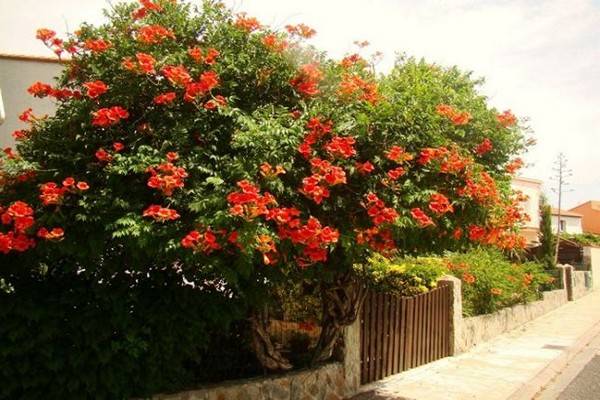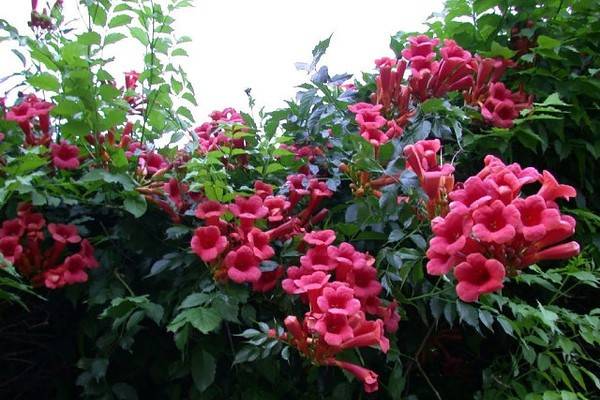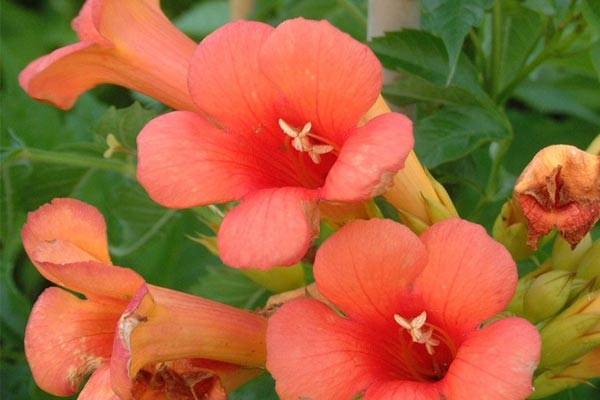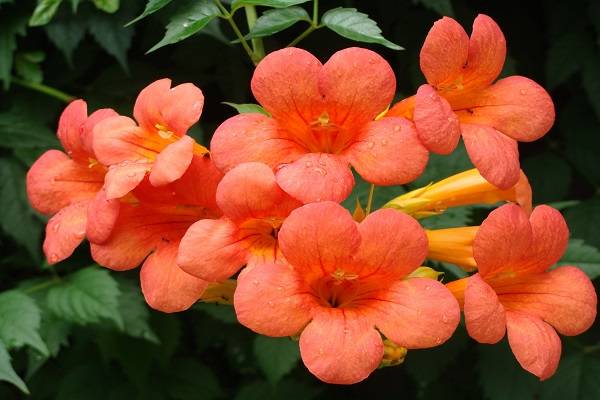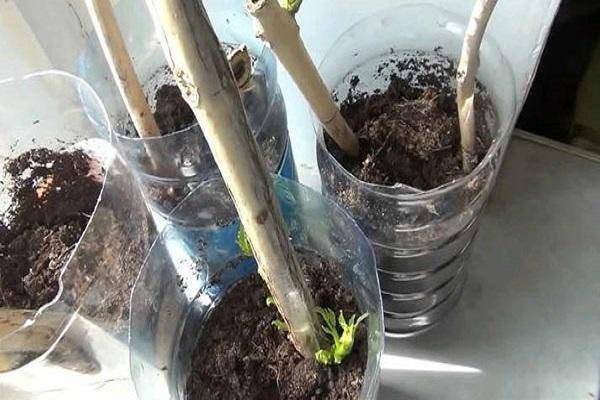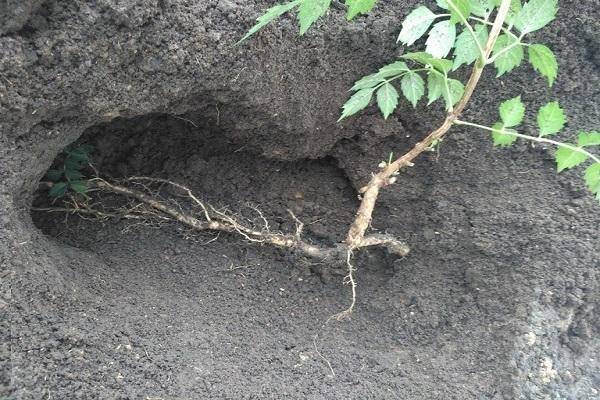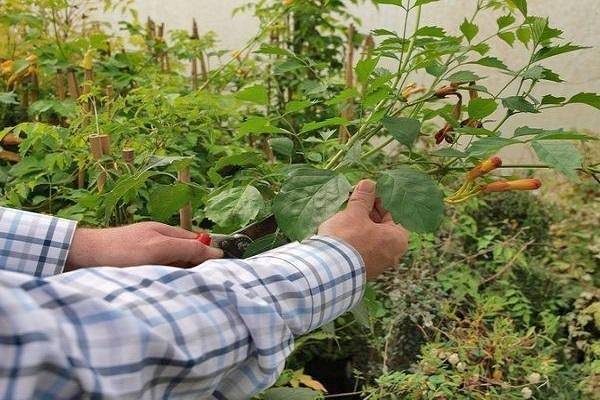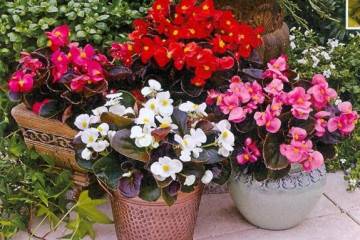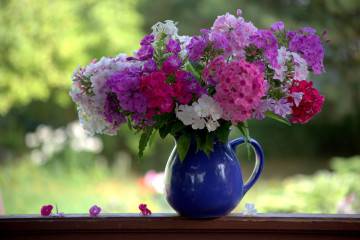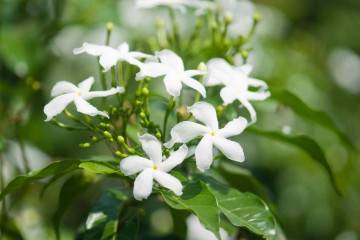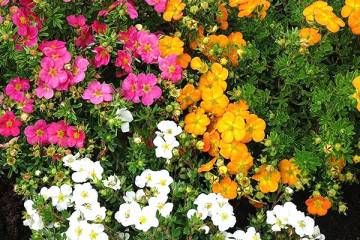Campsis liana (Campsis) - rooting, large-flowered, hybrid species
Content:
Campsis liana belongs to the ornamental species that are popular with Russian gardeners. The plant is used in landscape design, it is distinguished by minimal maintenance requirements, it decorates household plots with its bright and long-lasting flowers.
Features of Kampsis
Campsis is a flower that has spread because of its ability to grow in any, even difficult conditions. Improper care will not destroy the culture, but it will not give it the opportunity to bloom.
The domestication of the culture took place in the 17th century; it came to Europe from North America. The plant was used to form hedges, arches and gazebos. It appeared in Russia in the 18th century. and almost immediately took root in subtropical climatic zones.
Plant characteristics
The description of the culture gives the following:
- liana reaches a length of 15 m;
- increases annually by 1.5-2 m;
- initially shoots with a greenish tinge eventually turn brown and tree-like;
- large, up to 20 cm, green foliage consists of 7-11 small leaves, denticles are located at the edges;
- survives when the temperature falls to −20 ° С;
- after frost damage it is easily restored;
- not afraid of gas pollution in urban areas.
Kampsis classification
Biologists distinguish between two varieties of culture: rooting (Campsis Radicans) and large-flowered. The rest are hybrid.
Campsis rooting (Campsis Radicans), or bignonia rooting (Bignonia Radicans)
The cultivar came from North America. It grows up to 8-10 m in length. Rooting campsis blooms profusely, buds reach 5 cm in diameter.
Large-flowered campsis (Campsis Grandiflora), Chinese campsis, or Chinese bignonia (Bignonia Grandiflora)
Homeland of large-flowered campis Southeast Asia and China. Liana grows up to 15 m, is fixed on supports by stems, and not aerial roots. The flowers of the Kampsis are large-flowered, bright orange, pinkish-scarlet from the inside with a diameter of 8-9 cm. They are collected in inflorescences from 10 to 15 pcs. The plant is damaged by frost - 8-10 ° C.
Campsis hybrid (Campsis hybrida)
The variety appeared at the end of the 19th century, outwardly resembles a bush, and not a classic liana. It grows from 4 to 6 m, blooms profusely, tolerates a cold snap to -20 ° C.
Varieties that are in great demand among gardeners
Certain types of crops are grown more often than others, and this is due to varietal characteristics. Depending on the location of the region and the weather, flower growers prefer a certain version of the home vine.
Judy
The plant stretches up to 4 m, flowering is observed throughout the summer and until mid-October. The flowers are bright yellow with an orange core. Kampsis Judy has high frost resistance, the variety easily winters at -20 ° С. The culture is often grown in the southern regions and the Moscow region.
Flamenco
Differs in active growth, can reach 10 m. Buds appear in mid-July and persist until the third week of October. They have a dark red color, up to 8 cm in diameter. Flamenco does not react well to excess moisture, survives in frosts of -17 ° C.
Flava
It grows up to 15 m, the buds are large (4-5 cm in diameter) with a lemon-yellowish tinge. It blooms from June to October.
Gorgeous
Outwardly it resembles a shrub. Thin and long branches are adorned with orange-reddish flowers.
Golden
Differs in bright and yellowish flowers. Refers to a rooting species.
Early
Able to bloom a month earlier than other varieties. The buds are painted in scarlet, kumach, porphyry shades.
Dark purple
Possesses the standard characteristics of a kind. The difference is in large purple flowers.
Kampsis breeding methods
Reproduction of Kampsis is carried out by seeds, roots, cuttings and layering.
Growing from seeds
It is used in rare cases due to late flowering - not earlier than 7-8 years of age. Seed material is obtained from bivalve pods that form after the buds wilt.
Cuttings
How to propagate Kampsis by cuttings:
- In June or July, cuttings without flowers are harvested.
- They must be planted in pots or open ground.
- While waiting for the branches to take root, they need to be watered regularly.
How to propagate by root shoots
The culture is actively developing a root system, which can appear at a considerable distance from the mother bush - up to several meters. The shoots, together with part of the root, are dug up in early spring and planted separately. Rapid development allows new plants to bloom 2-3 years after planting.
Reproduction by layering
The procedure takes place step by step:
- The shoot is fixed in the internode area in a small hole.
- The soil is moistened.
- After the roots appear, the seedling is separated from the main bush and sent to a permanent place.
Seed planting by seedling method
Seed propagation is one of the simplest methods. The seed collected in October retains the ability to grow until spring.
Time to board
Planting procedures are carried out in February-March, depending on the region.
Choice of capacity
The boxes should be shallow with drainage. The lack of holes can cause stagnant water and rotting of young plants.
Soil and seed preparation
Loose soil with a neutral reaction is poured into the container. The seeds do not require special processing or stratification. Stripes up to 0.5 cm deep are drawn in the soil, sown and carefully sprinkled with earth. They will sprout within a month.
Seedling care
Plants are watered as the earth dries up using a drip method.
Dive
After the appearance of the first 6 leaves, a transplant is carried out: the sprouts are separated and planted in separate cups.
Features of planting in a seedless way in open ground
Liana is planted under the open sky in April or May, but even with an autumn planting, the culture has time to adapt to new conditions.
When cuttings flowering should be expected in 2-3 years, when using seeds - not earlier than in 5-8 years.
Features of care in the garden
If it is decided to grow kampsis, planting and care will not be difficult, even for inexperienced gardeners.
For long-term flowering, the culture needs the sun, location in the shade leads to crushing and fading of the buds. The plant is planted in an open area, on the north side, it must be protected from the cold wind.
The culture does not tolerate excessive soil moisture. Wetlands and places where groundwater is located closer than 1 m to the surface are not suitable for it.
Watering
The culture is calm about dry weather, but reacts poorly to water accumulated at the roots. In May-June, the soil is moistened every 5 days, then the interval between waterings is increased to 1 week. For each adult plant, 15 liters of water are consumed; after the end of flowering, there is enough precipitation.
Mulching
Peat or humus is used for mulch, the procedure is carried out after each watering.
Loosening
Held every two weeks. Simultaneously with loosening, you need to get rid of weeds.
Top dressing
In fertile soil, the plant is not fed. Fertilizers are applied twice a year - in April and during flowering. Use fertilizing with nitrogen, potassium and phosphorus or a complex solution for decorative flowering species.
When and how it blooms
The bud formation time depends on the variety. Why doesn't Kampsis bloom? Due to improper care, excess or lack of moisture, attacks of insect pests.
Types of flowers
In nature, the color of the petals is orange-reddish. Breeding varieties have:
- crimson purple;
- pinkish;
- golden orange;
- bright yellow.
The flowers are collected in loose inflorescences that resemble panicles.
Flower shapes
Externally, the buds resemble a horn or bell 9 cm long and 4 to 5 cm in diameter.
Flowering period
Flowers appear in large quantities in July and bloom in September. A feature of liana is the lack of smell in the buds.
Changes in care during flowering
During budding, you need to increase the number of watering, feed the bushes.
Post-flowering care
When planting and nursing in the open field, Kampsis needs pruning, preparatory measures before the winter period.
Pruning
The procedure helps to maintain a decorative appearance. In spring, 4-5 of the strongest are left from the side shoots, the rest are excised. Every year you need to prune at the level of 3-4 growth buds. Sick, weak and damaged branches are disposed of.
Preparing for winter
In late autumn, the shoots are removed from the supports, thrown in a thick layer:
- sawdust;
- foliage;
- needles.
The use of covering material is allowed. Near the base of the stems, small mounds are laid out, consisting of humus or peat (up to 20 cm).
Possible growing problems
The culture is not afraid of most diseases and insect pests. The main problems arise when the rules for caring for vines are violated.
Pests
Aphids are the main enemy of the plant. Insects capture shoots in whole colonies, preference is given to young shoots, from which they suck the juice.Preventive spraying of aerial parts is carried out with onion, garlic, citrus and herbal infusions with a characteristic unpleasant odor.
Diseases
Root rot is a serious threat to lianas. The disease is formed due to excessive moisture in the earth. The main symptoms include:
- soft and brownish stems at the base;
- spots on foliage;
- the presence of mold on the ground.
Therapy consists in a sharp decrease in the frequency of watering, treatment of plants with a solution of potassium permanganate. The use of fungicidal preparations is allowed: maxim, previcur, bayleton, alirin-B.
Signs of improper care
The main symptom is the lack of flowering. The cause of the anomaly is associated with drafts, strong winds and frost. Yellowing and curling of leaves occurs with insufficient or over-watering. It is impossible to make a vine bloom without proper care.
Campsis is distinguished by its unpretentiousness; even a beginner in floriculture can grow it. To obtain healthy thickets, you need not to flood the vine, feed it twice a year and do not forget about pruning. The plant is not poisonous, not dangerous for pets and children. More than it, it blooms very effectively to the envy of all neighbors.
